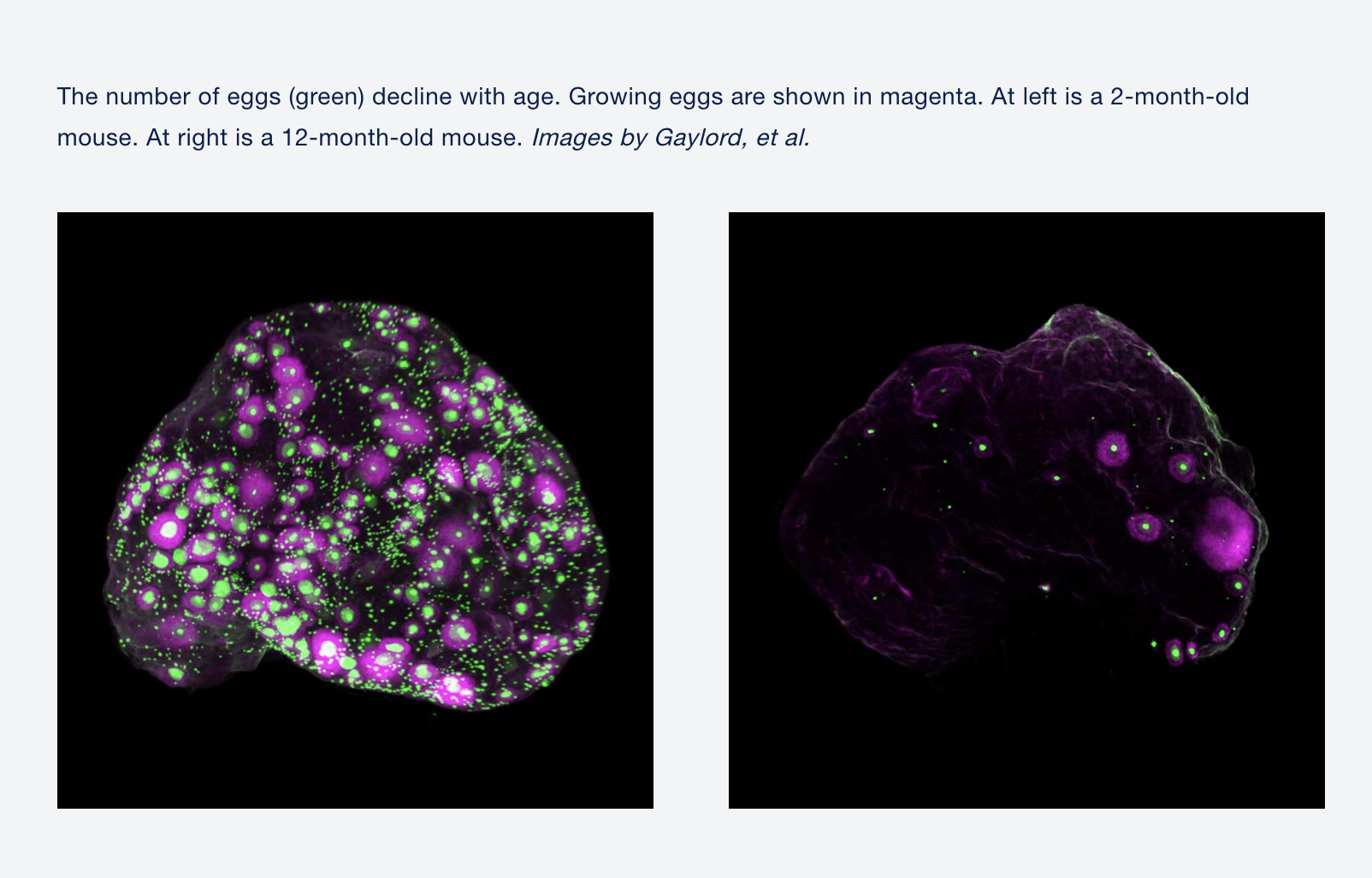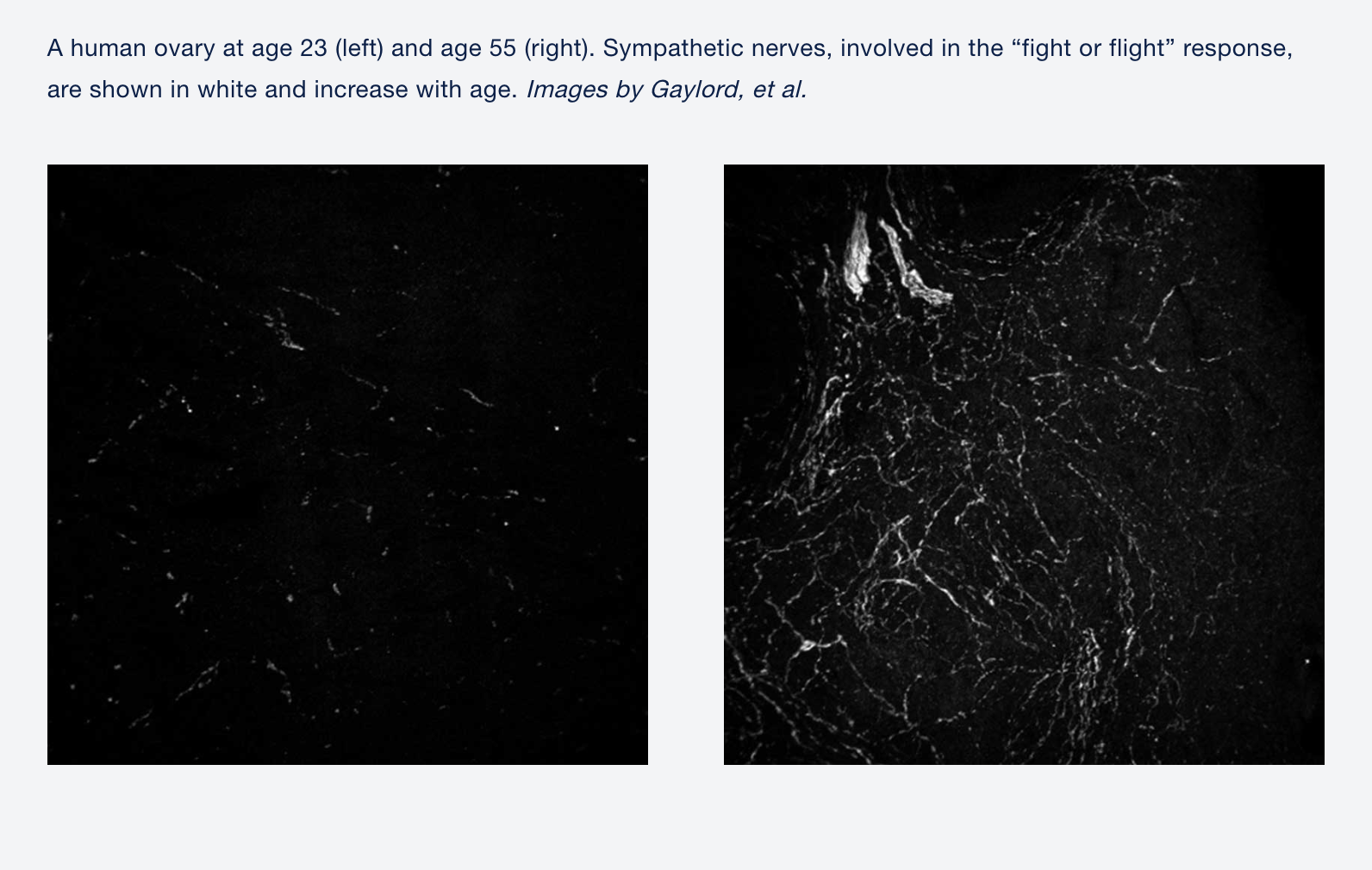The Newly Discovered Ecosystem of Ovaries -and How Red Light Therapy May Help it Thrive
The Hidden Ecosystem of the Ovaries
A new discovery from UCSF shows something extraordinary inside our ovaries, an amazing intricate ecosystem of cells, nerves, and connective tissue that plays a vital role in fertility. For decades, science has focused primarily on eggs themselves, but this new research reveals that fertility depends just as much on the environment surrounding those eggs, a living network that nourishes, communicates, and responds to every hormonal shift.
Some of the Key Findings
Between age 25 and 40, a woman’s chance of conceiving per cycle drops from ~25 % to <5 %.
The UCSF team sequenced ~100,000 ovarian cells, revealing 11 distinct cell types, including glial‑like support cells never before identified in human ovaries.
Fibroblast‑driven scarring was visible decades earlier in ovaries than in other organs (lungs or liver).
Sympathetic nerve fibers thicken markedly with age; removing them in mice disrupted normal egg maturation, proving the nervous system regulates the ovary directly (stress!)
And perhaps most exciting of all? The way this system functions appears deeply connected to energy, circulation, and mitochondrial activity, areas already known to respond to photobiomodulation or red light therapy.
Let’s look at what the scientists discovered and and why it matters for women trying to conceive, restore hormonal balance, support ovarian health and overall longevity.
Mice ovaries are very similar to human female ovaries.
The Ovary’s Hidden Architecture: Pockets, Nerves, and Fibroblasts
Researchers at UCSF recently uncovered something extraordinary: the ovary isn’t just a simple egg vault it’s a complex, interdependent ecosystem. Using advanced 3‑D imaging and special single‑cell sequencing, scientists discovered that eggs live in specialized “pockets” surrounded by zones without eggs. Each pocket has its own concentration of blood flow, connective tissue, and nerve networks, suggesting that fertility depends not just on egg count, but on the environment those eggs live in. Each pocket is its own neighborhood, complete with roads for blood flow, communication lines through nerves, and scaffolding that keeps everything connected. As the infrastructure ages or weakens, even strong houses (eggs) struggle.
With age, the density of eggs within these clusters drops, and so does the quality of their surrounding ecosystem. The fibroblasts that build the tissue structure begin to stiffen and scar earlier than in almost any other organ. This early-onset “ovarian fibrosis” reduces circulation and oxygen delivery, a process that mirrors what we see in skin aging or wound repair.
At the same time, UCSF researchers discovered that glial cells (the same support cells found in the brain) and sympathetic nerves play vital roles in when and how eggs begin to mature. These sympathetic nerves increase with age, ramping up “fight‑or‑flight” activity inside the ovary. Too much signaling appears to drain egg reserves faster, while too little impairs maturation. The study shows that the ovary is not just hormonal, it’s electrical, structural, and energetic. Managing oxidative stress and restoring energy balance becomes essential for keeping this entire network in harmony.
Fibroblasts, the body’s builders, which create structural proteins like collagen, maintain the tissue “scaffolding,” and signal when repair is needed (but as we age they can cause scarring).
Glial-like cells, often associated with the brain, that help coordinate hormonal signaling and inflammatory responses.
Sympathetic nerves, which regulate blood flow and connect the ovary’s internal rhythms with the rest of the body.
When this microenvironment breaks down with age, as fibroblasts weaken and inflammation increases, the ovary’s ability to mature eggs and respond to hormones seems to slow down. Fertility, then, isn’t simply about egg count or age, it’s about the health of this entire complex ecosystem.
“This represents a paradigm shift: just as we now recognize the gut and vaginal microbiomes as essential ecosystems, the same principle applies to reproductive health. The ovarian microenvironment determines whether eggs have the energy, oxygen, and structural support to thrive.”
Why Fibroblasts Are the Unsung Heroes
One of the most eye-opening aspects of this discovery is the role of fibroblasts, which act as both architects and communicators within tissues. These cells don’t just build; they send chemical “instructions” that guide blood vessel formation, immune response, and hormonal exchange between the ovary and the rest of the body. And guess what - we have a ton of research on red light therapy and fibroblasts!
When fibroblast activity declines, connective tissue weakens, blood flow stagnates, and inflammation climbs, creating stress for both ovarian and hormonal function. They can increase scarring in the ovarian tissue.
Studies show that fibroblasts respond powerfully to light. A 2025 paper in Frontiers in Bioengineering and Biotechnology revealed that photobiomodulation activates fibroblast healing pathways through PI3K/AKT and TGF‑β signaling, boosting collagen production, circulation, and antioxidant defense. Earlier research confirmed that PBM can increase mitochondrial energy, reduce oxidative stress, and accelerate tissue repair by activating cytochrome‑c oxidase, the key enzyme that converts light into cellular energy.
This fibroblast connection bridges cellular regeneration research with the ovarian ecosystem discovery: PBM doesn’t just act on eggs or hormones - it supports the matrix of cells that keep reproductive tissues energized and functional.
Where Red Light Therapy for Fertility Fits In
Red and near‑infrared light therapy works by restoring mitochondrial function, improving microcirculation, and reducing oxidative stress. These effects extend to the same structural and metabolic networks that the ovarian discovery describes.
Recent research has demonstrated PBM’s impact on ovarian tissue:
· A Scientific Reports study (2024) found that PBM reversed ovarian aging in mice by reducing inflammation and enhancing blood vessel growth, leading to more follicles reaching maturity.
· A 2025 review in Frontiers in Physiology confirmed PBM improves mitochondrial density and oocyte energy metabolism, supporting ovarian reserve and hormone production.
By targeting mitochondria within both ovarian fibroblasts and granulosa cells, PBM helps improve the overall architecture of reproductive tissue. Enhanced fibroblast activity means stronger collagen, better vascular support, and faster resolution of inflammation — key conditions for follicle growth and implantation success.
In short, red light therapy doesn’t just revive egg health — it rejuvenates the soil the eggs grow in.
What’s Missing for Women Trying to Conceive
While the New Scientist article revealed the “what,” it didn’t explore the “how.” You might be reading this scratching your head thinking, Ok So how do I actually help this ecosystem?
Here’s the key: the health of this ovarian microenvironment is influenced by factors women can actively track and support.
1. Circulation and oxygenation: PBM improves blood flow to the ovaries and uterus by increasing nitric oxide and capillary formation.
2. Inflammation and oxidative stress: PBM naturally reduces chronic low‑grade inflammation that interferes with follicle development.
3. Connective tissue integrity: By stimulating fibroblasts, PBM strengthens the ovarian stroma — the structural lattice that nourishes follicles and maintains hormone exchange.
4. Hormonal stability: Over several cycles, women may see smoother menstrual patterns, more fertile cervical mucus, consistent ovulation, and fewer PMS symptoms.
Together, these shifts create measurable, observable changes for women tracking fertility at home — whether through BBT, cervical mucus, or lab tests such as AMH, FSH, estradiol, and progesterone. (Learn what’s important to track when using red light therapy).
Why This Matters for Women Using Red Light Therapy
These same cells, the fibroblasts, glia, and nerves that underpin ovarian vitality - are all profoundly responsive to light! Mitochondria within them act as tiny photo‑receptors, making red light therapy a natural ally for this newly mapped ovarian ecosystem. This new biological map of the ovary changes how we think about fertility. It turns out that a woman’s reproductive health depends on the same things red light therapy supports most powerfully: mitochondrial energy, fibroblast repair, and balanced nerve signaling.
Mitochondria: PBM at near‑infrared wavelengths (around 810 - 830 nm) restores mitochondrial ATP production, improving the oxygenation and energy supply that every egg and fibroblast depend on.
Fibroblasts: Red‑to‑NIR PBM stimulates fibroblast regeneration, boosting collagen synthesis and reducing scarring that would otherwise harden tissue structure around the egg pockets.
Sympathetic‑nerve overactivity: PBM has known neuromodulatory effects. It calms excessive sympathetic tone and shifts the body toward parasympathetic (rest‑and‑repair) dominance — the same balance the ovary needs to regulate egg growth cycles naturally. In plain English this means managing stress is a key part of this ecosystem.
Chronic Stress Also Plays a Role
The sympathetic nervous system (SNS) governs our “fight‑or‑flight” response. When it’s persistently activated by chronic psychological or physiological stress, it keeps the body in a high‑alert mode, prioritizing survival over baby making. Ongoing stress constricts blood vessels, diverts nutrients away from the ovaries, and suppresses reproductive hormone signaling. Studies show that this dysregulation delays or disrupts ovulation, lowers implantation rates, and impairs egg quality.
From a fertility standpoint, this means stress‑induced sympathetic dominance can cause the ovarian environment to become hostile to maturation and implantation. PBM’s “neuromodulatory effects” refer to its ability to shift this imbalance, reducing sympathetic activity and improving parasympathetic (“rest‑and‑repair”) tone, helping normalize blood flow and hormone rhythm. As sympathetic activity increases with age, or under chronic stress the ovary’s ‘fight‑or‑flight’ wiring can burn through reserves faster. Photobiomodulation helps rebalance this by soothing the stress axis, promoting parasympathetic recovery, and improving ovarian blood flow.
(If you’ve purchased your device through my affiliate links, booked a consult with me or purchased my laser you also receive complimentary access to my FertileMind app - a mindfulness based approach to fertility related stress.
Human ovary at 23 (not a lot of stress) and at 55 - years of unmanaged stress.
How PBM helps with nervous‑system balance
Multiple studies confirm that PBM influences autonomic balance through mitochondrial and nitric‑oxide pathways. Light absorbed by cytochrome c oxidase increases ATP and nitric oxide, which improves vasodilation, tissue oxygenation, and neurochemical equilibrium. In the brain and peripheral nerves, red light therapy reduces overactivity of stress circuits and enhances vagal (parasympathetic) tone, key for restoring reproductive readiness.
As you can see, these are not abstract biochemical events, they are visible in how women feel and what they observe in their cycles. Red light therapy users often notice better warmth and circulation in the pelvic area, improved mucus quality, and more stable luteal‑phase patterns after a few months of consistent use. (We saw this in the images from the Ohshiro research).
The discovery of the ovarian ecosystem reminded us that every cell relies on the health of its community. With its ability to repair fibroblasts, improve blood flow, and optimize mitochondrial communication, photobiomodulation stands out as one of the few tools capable of nurturing that ecosystem from the inside out.
Tracy
Resources:
Frontiers in Bioengineering & Biotechnology (2025). Photobiomodulation in Fibroblasts: From Light to Healing through Signaling Networks.
Hauss et al. (2021). Photobiomodulation of Human Fibroblasts and Keratinocytes with 660 nm and 808 nm Light Increases ATP and Collagen.
https://www.sciencedirect.com/science/article/abs/pii/S1011134424001842


